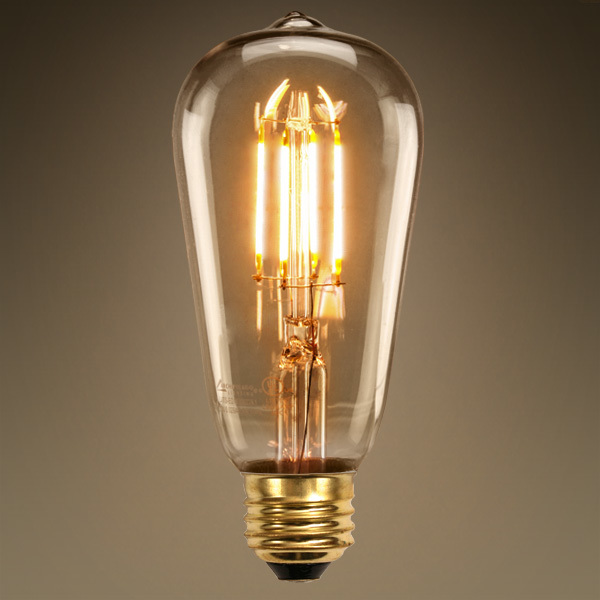By Guest Blogger, Jason Krist of Jason Krist Electric
So, you finally used the last lightbulb from your garage backup stockpile. You head to your neighborhood big box store to replenish your stock, but when you get to the lightbulb aisle, you suddenly feel as if you’ve stepped into a parallel universe.
Where the familiar filament bulbs you’ve used your entire life should be, you find a dizzying array of futuristic-looking LED bulbs. You’re pretty sure a 9 watt bulb ain’t gonna do it, but the details on their packaging, such as ‘3000K’ and ‘90CRI,’ only serve to further confuse you.
Let’s see if I can shine a little light (grimace) on the subject. For now we’ll focus on light bulbs (henceforth referred to as lamps), and leave dedicated LED fixtures, lighting control devices, and other related topics for another time.
The standard incandescent filament lamp needs no special descriptors other than wattage, which we all understand to relate to brightness. The other two important characteristics of a light source, color temperature, or CCT, expressed as Kelvin temperature (k), and color rendering index, or CRI, are constant with filament lamps, so that is why you don’t see those ratings on their packaging. The color is around 2700K, which translates to very warm, and the CRI is 100, which means objects illuminated by the lamp show their true colors. Each color you see is a product of a specific wavelength of energy that, when striking an object, causes that color to be reflected back at you. The fuller and wider the spectrum of wavelengths, the more colors you see. CRI is a rating scale from 1 to 100, 100 indicating as close as possible to natural daylight; this is also the rating for incandescent light. As a point of comparison: Ever been in a parking garage at night, having a hard time telling what color anything is? High pressure sodium lamps, frequently employed in this type of setting, have a CRI of about 24.
Are your eyes beginning to glaze? Ok, let’s move past the technical, and offer some advice on how to purchase LED lamps to replace those comfortable, familiar, but highly inefficient and dwindling-in- availability incandescent lamps.
First of all let’s understand wattage. Wattage refers to energy consumed, and since 80% or more of a standard incandescent lamp’s energy is used to produce heat rather than light. It requires many more watts to generate the same amount of light as an LED lamp, which converts over 90% of its energy consumption into light. Most LED lamp packaging now includes comparison wattages for your benefit. Don’t be suspicious! A 9 watt LED lamp is very bright! It’s not sitting around wasting your PG&E dollars producing large amounts of heat, rather than light, and singlehandedly causing your air conditioning to kick on in the warmer months.
Next, on to color temperature, or degrees kelvin (k). Sometimes a client will tell me they’d like 5000k lighting installed because they heard it described as “daylight”. Everyone enjoys daylight, right? Well, 5000k with a blue sky and filtered through atmospheric particles appears very different from 5000k in your house, where it will look pretty much like every interior shot from a futuristic science fiction movie. You know, kind of blueish, and very chilly.
For most areas of your home I recommend 2700k, always. For task related areas such as the kitchen, 3000k is a viable option. The higher temp is cooler and simulates daylight, and as such the body’s natural senses tell it that it should be awake and in motion. The lower temp lighting elsewhere tells the body, just like the sky as sunset approaches, to start winding down. You know, create melatonin. Chill.
Lastly, choosing CRI is not much of a choice at all. The closer to 100, the better. Some LED lamps are still rated around 80: Okay for garages and less-used parts of the house, but not optimal for any location where seeing true colors is important to you. 90 CRI or more is what you should shoot for.
Finally, you may be somewhat confused by the broad range of prices charged for LED lamps and fixtures if you shop outside of big box stores, where the main focus is low price. The reasons for the large price variances are a topic unto itself. For now let me just say the LED market is like the Wild West — short on rules and enforcement, long on young, unproven guns jumping into the market, vying for dominance. My advice? At the risk of sounding like a corporate shill, stick with recognized brands with a history of quality, such as Philips, GE, and Cree.
Hopefully I’ve been able to help demystify this exciting new chapter in the evolution of lighting technology, or at least make your next light bulb foraging expedition less painful. And remember, stop worrying!
Look for upcoming blogs where I’ll discuss selection of other LED light sources as well as the topics of lighting control and energy efficiency standards as they continue to evolve.
____________________________________________________________________________________________________________
 Jason Takeuchi-Krist, is the owner of Krist Electric, Inc., electrical contractors performing both residential and commercial electrical work, primarily in Sonoma County. They specialize in lighting design and installation, and residential remodels. Formerly, Jason was a professional chef in San Francisco as well as a blacksmith. His creative and artistic background led him to develop a particular passion for lighting and its vast creative and functional possibilities.
Jason Takeuchi-Krist, is the owner of Krist Electric, Inc., electrical contractors performing both residential and commercial electrical work, primarily in Sonoma County. They specialize in lighting design and installation, and residential remodels. Formerly, Jason was a professional chef in San Francisco as well as a blacksmith. His creative and artistic background led him to develop a particular passion for lighting and its vast creative and functional possibilities.
Krist Electric, Inc
510-421-1680 •


Recent Comments